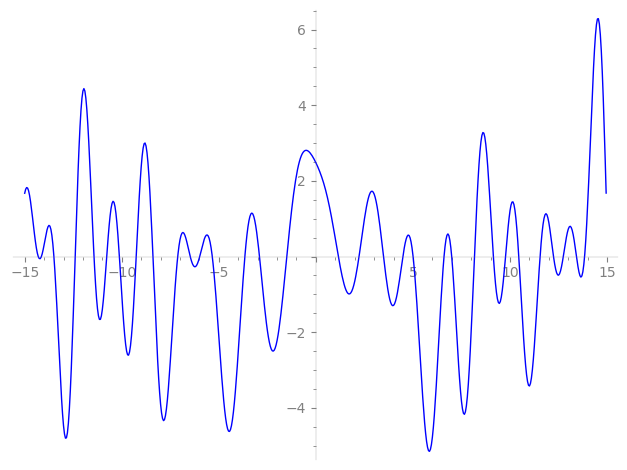| L(s) = 1 | + (0.5 + 0.866i)2-s + (0.500 − 0.866i)4-s + (1.5 + 2.59i)5-s + (−2 + 1.73i)7-s + 3·8-s + (−1.5 + 2.59i)10-s + (3 − 5.19i)11-s + 13-s + (−2.5 − 0.866i)14-s + (0.500 + 0.866i)16-s + (−0.5 + 0.866i)17-s + (2 + 3.46i)19-s + 3·20-s + 6·22-s + (2 + 3.46i)23-s + ⋯ |
| L(s) = 1 | + (0.353 + 0.612i)2-s + (0.250 − 0.433i)4-s + (0.670 + 1.16i)5-s + (−0.755 + 0.654i)7-s + 1.06·8-s + (−0.474 + 0.821i)10-s + (0.904 − 1.56i)11-s + 0.277·13-s + (−0.668 − 0.231i)14-s + (0.125 + 0.216i)16-s + (−0.121 + 0.210i)17-s + (0.458 + 0.794i)19-s + 0.670·20-s + 1.27·22-s + (0.417 + 0.722i)23-s + ⋯ |
Λ(s)=(=(1071s/2ΓC(s)L(s)(0.386−0.922i)Λ(2−s)
Λ(s)=(=(1071s/2ΓC(s+1/2)L(s)(0.386−0.922i)Λ(1−s)
| Degree: |
2 |
| Conductor: |
1071
= 32⋅7⋅17
|
| Sign: |
0.386−0.922i
|
| Analytic conductor: |
8.55197 |
| Root analytic conductor: |
2.92437 |
| Motivic weight: |
1 |
| Rational: |
no |
| Arithmetic: |
yes |
| Character: |
χ1071(613,⋅)
|
| Primitive: |
yes
|
| Self-dual: |
no
|
| Analytic rank: |
0
|
| Selberg data: |
(2, 1071, ( :1/2), 0.386−0.922i)
|
Particular Values
| L(1) |
≈ |
2.479321056 |
| L(21) |
≈ |
2.479321056 |
| L(23) |
|
not available |
| L(1) |
|
not available |
L(s)=p∏Fp(p−s)−1 | p | Fp(T) |
|---|
| bad | 3 | 1 |
| 7 | 1+(2−1.73i)T |
| 17 | 1+(0.5−0.866i)T |
| good | 2 | 1+(−0.5−0.866i)T+(−1+1.73i)T2 |
| 5 | 1+(−1.5−2.59i)T+(−2.5+4.33i)T2 |
| 11 | 1+(−3+5.19i)T+(−5.5−9.52i)T2 |
| 13 | 1−T+13T2 |
| 19 | 1+(−2−3.46i)T+(−9.5+16.4i)T2 |
| 23 | 1+(−2−3.46i)T+(−11.5+19.9i)T2 |
| 29 | 1−7T+29T2 |
| 31 | 1+(3.5−6.06i)T+(−15.5−26.8i)T2 |
| 37 | 1+(4+6.92i)T+(−18.5+32.0i)T2 |
| 41 | 1+3T+41T2 |
| 43 | 1+8T+43T2 |
| 47 | 1+(−3.5−6.06i)T+(−23.5+40.7i)T2 |
| 53 | 1+(2−3.46i)T+(−26.5−45.8i)T2 |
| 59 | 1+(2.5−4.33i)T+(−29.5−51.0i)T2 |
| 61 | 1+(2+3.46i)T+(−30.5+52.8i)T2 |
| 67 | 1+(2−3.46i)T+(−33.5−58.0i)T2 |
| 71 | 1−16T+71T2 |
| 73 | 1+(−1+1.73i)T+(−36.5−63.2i)T2 |
| 79 | 1+(−4−6.92i)T+(−39.5+68.4i)T2 |
| 83 | 1+9T+83T2 |
| 89 | 1+(7+12.1i)T+(−44.5+77.0i)T2 |
| 97 | 1−8T+97T2 |
| show more | |
| show less | |
L(s)=p∏ j=1∏2(1−αj,pp−s)−1
Imaginary part of the first few zeros on the critical line
−10.12237919082952657319622433503, −9.257128849302038995483283601708, −8.393056621694735950159986182568, −7.11728869835905466669126672404, −6.47281252993319693230881983875, −5.98594335069302067964830398988, −5.33767484341052500650891695341, −3.65890322653304908679200282535, −2.90577556172763788980181151164, −1.49919855892003166702434593954,
1.15807201173852546747242214322, 2.22103824551955356977735315487, 3.48383452675271022971091152555, 4.47933589507849181220015900441, 5.00556484727790607526042897580, 6.59957024545222033655778502661, 6.99493873357664471222860795373, 8.165829775413167881415288830911, 9.141596268552397601724739856327, 9.767731668144289755730142869259

